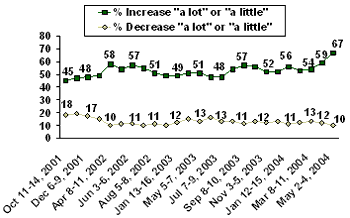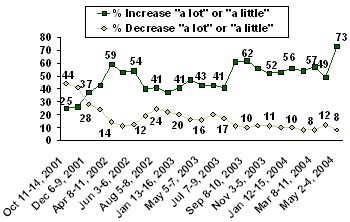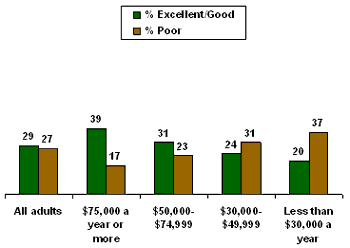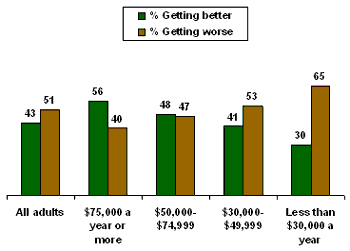GALLUP NEWS SERVICE
PRINCETON, NJ -- Last Friday's job report suggests that new hiring is finally beginning to happen in the U.S. economy, with the addition of 600,000 new jobs over the past two months. Add in the fact that the economy continued to expand at a 4% annual rate during the first quarter, and one might reasonably assume that consumers have good cause to be increasingly optimistic about the economic outlook.
New Gallup Poll economic data, however, show just the opposite. In early May, more consumers rate current economic conditions as "poor" than at any time this year. Even more surprisingly, half the public thinks the economy is "getting worse" as opposed to "getting better" -- nearly twice the number who held that view in January. Combined, these two key findings suggest that consumer confidence is now at its lowest point of the year.
Why is consumer confidence declining just when the economic expansion finally seems to be building some positive momentum? Part of the explanation may involve growing consumer concerns about increasing prices and higher interest rates. Another part lies in the way higher-income consumers remain much more optimistic about the economy and its future prospects than do their middle- and lower-income counterparts.
Inflation Expectations Increase in May
Two in three Americans tell Gallup they expect inflation to increase over the next six months. This is up eight percentage points from April and is the highest percentage of the public expecting prices to go up since Gallup began measuring inflation expectations in October 2001.
| Americans’ Expectations for
Inflation Over the Next Six Months |
 |
Interest-Rate Fears Surge in May
Nearly three in four Americans also say they expect interest rates to increase over the next six months. This is up 24 percentage points from April, and -- as is the case with inflation fears -- is the highest percentage of the public expecting interest rates to go up since Gallup began measuring interest-rate expectations in October 2001.
| Americans’ Expectations for Interest
Rates Over the Next Six Months |
 |
Income Groups Rate Economic Conditions Differently
Overall, more than one in four consumers (27%) say current economic conditions are "poor" -- up five percentage points from April and the highest number holding this view at any time this year. The gap between those saying current economic conditions are "excellent" or "good" (29%) and those saying conditions are "poor" is only +2 percentage points.
However, these ratings differ significantly across consumer income groups. Thirty-nine percent of consumers making $75,000 or more annually rate current economic conditions as good or excellent, while only 17% rate them as poor -- a difference of +22 percentage points. In sharp contrast, only 20% of consumers with annual incomes of less than $30,000 rate current economic conditions as excellent or good, while 37% rate them as poor -- a difference of -17 percentage points. In general, consumer ratings of the economy improve significantly as income increases across the consumer income distribution.
| Current Economic Conditions by income distribution |
 |
| May 2-4, 2004 |
Income Groups See the Economy's Direction Differently
Overall, fewer consumers say economic conditions are "getting better" (43%) than say they are getting worse (51%) -- a difference of -8 percentage points. However, once again, there are significant differences across consumer income groups. Fifty-six percent of consumers with annual incomes of $75,000 or more say economic conditions are getting better, while only 40% say they are getting worse -- a difference of +16 percentage points. In contrast, only 30% of consumers with annual incomes of less than $30,000 say economic conditions are getting better, while 65% say they are getting worse -- a difference of -35 percentage points. In general, consumer optimism about the future direction of the economy also increases significantly as income increases across the consumer income distribution.
| Economic Outlook by income distribution |
 |
| May 2-4, 2004 |
Income Differences May Explain a Lot
It is not surprising that consumers are much more worried about inflation, given the record level of gas prices. Nor is it unexpected that consumers worry about increasing interest rates, given the economic expansion, higher prices, and the hints provided by the Federal Reserve Board.
While all consumer groups share fears of higher prices and increasing interest rates, those in the middle- and lower-income segments are more likely than those in the higher-income groups to experience significant financial hardship immediately. Lower- and middle-income consumers have been most directly affected by the weak job market and wage compression during recent years. Although job growth has improved in the past two months, this trend will need to continue for some time before employees begin to see significant income gains. As a result, they are less able to deal with the financial pressures presented by increasing prices.
On the other hand, higher-income consumers continue to benefit more from home equity and stock market gains than do those with lower and middle incomes. As a result, the former seem much more likely to see real benefits from the growing economy and much less likely to find increasing prices presenting a significant financial hardship.
In sum, Gallup's economic data suggest that the trend in the consumer confidence data is not nearly as counterintuitive as it may appear. Higher-income consumers who are benefiting from the current economic expansion remain optimistic about the economy. Lower- and middle-income consumers are showing much less confidence in the economy because they are being squeezed by increasing prices in the midst of a wage compression.
While this disparity in economic perceptions across income groups may mean that the overall downward trend in consumer confidence will continue to be manageable economically, the same may not be true politically. Even as the economy continues to show signs that the economic expansion is gaining momentum, only 41% of the American public approves of the way the president is handling the economy -- the lowest level for him on this measure since Gallup began tracking it in February 2001.
Survey Methods
Results are based on telephone interviews with 1,000 national adults, aged 18 and older, conducted May 2-4, 2004. For results based on this total sample, one can say with 95% confidence that the margin of sampling error is ±3 percentage points. In addition to sampling error, question wording and practical difficulties in conducting surveys can introduce error or bias into the findings of public opinion polls.
